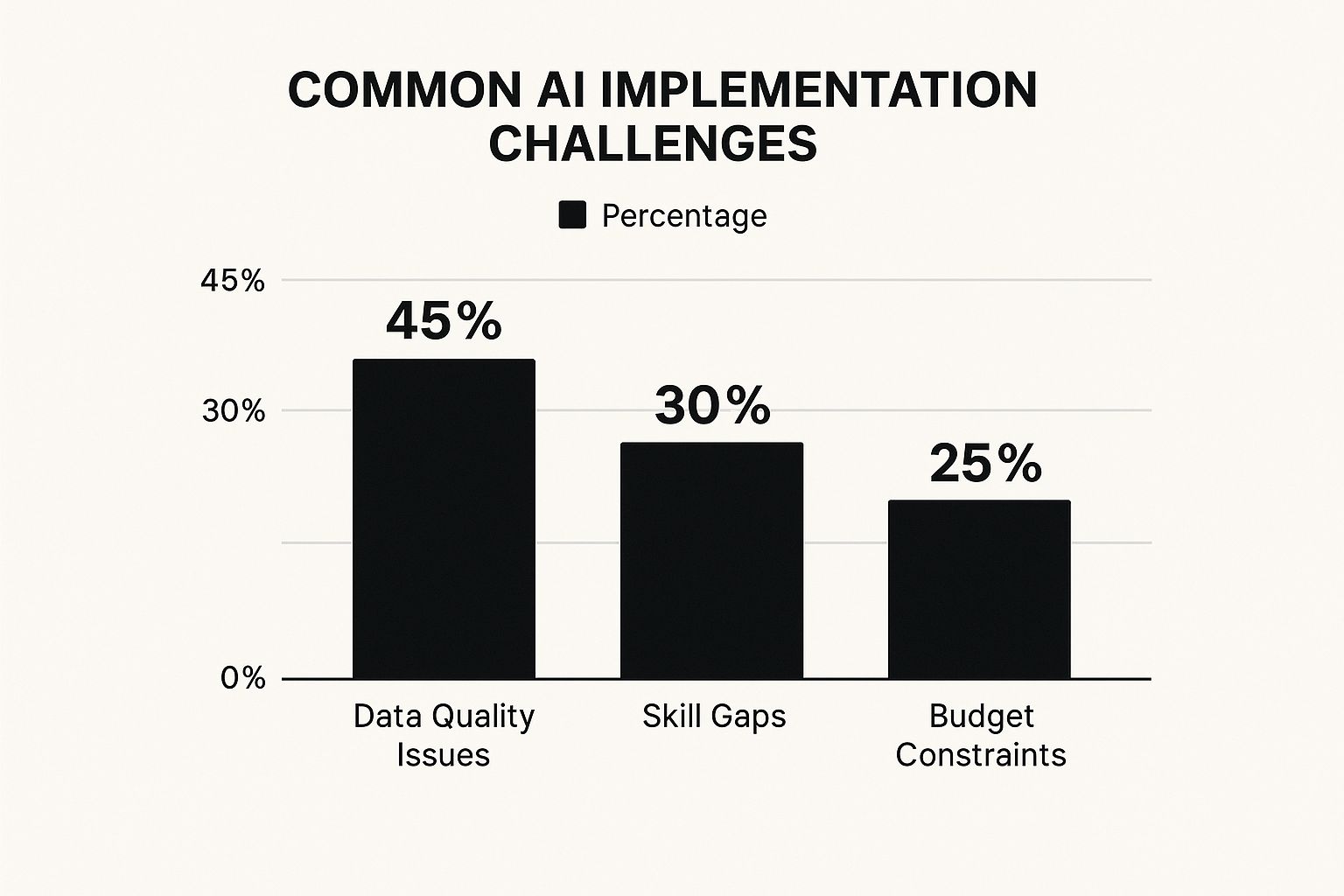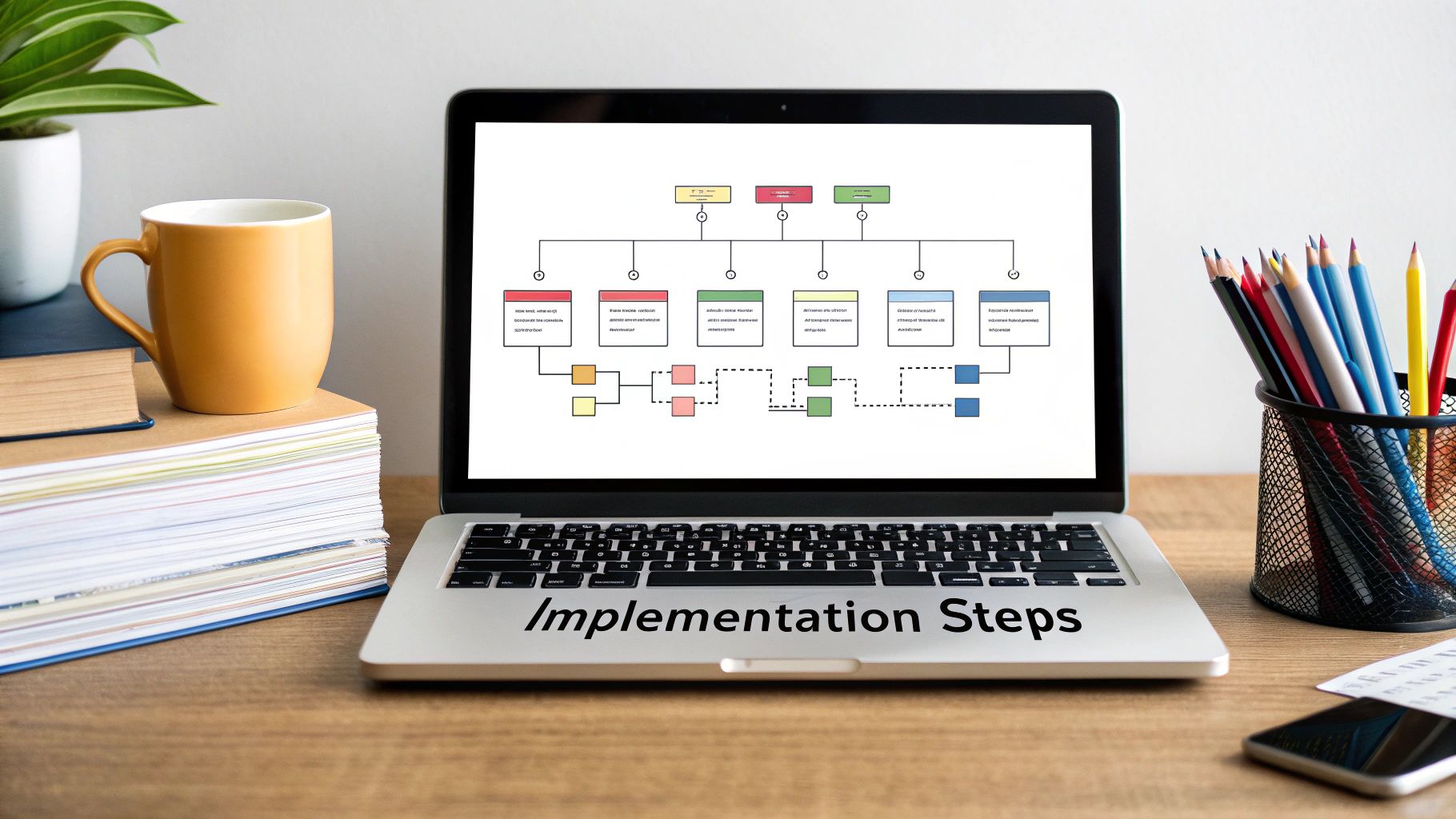AI Implementation Guide: From Strategy to Scale-Up
Master AI implementation with proven strategies from industry veterans. Discover actionable insights for successful AI integration that drives results.

Understanding AI Implementation in Today's Business World
Thinking about AI implementation can often feel like trying to jump onto a moving train. It’s speeding ahead, everyone’s talking about it, but figuring out the right moment to get on board isn't always obvious. The truth is, it’s less about a dramatic leap and more about a series of deliberate, well-planned steps. It means looking past the buzzwords to see where intelligent automation and data analysis can solve genuine, tangible problems within your specific business. Successful AI adoption isn't about chasing every new gadget; it’s about a fundamental mindset shift that positions AI as a core business function, much like marketing or finance.
No patience to read through the whole thing about AI implementation? You should probably explore a proven AI Strategy Consulting team that helps you co-create the most potential AI opportunities from strategy to product.
From Hype to Practical Application
The journey starts with an honest look at where your organisation currently stands. For many, the first move isn't to build a world-changing, self-aware system. Instead, it’s about automating repetitive tasks to free up your team for more strategic work. Imagine a customer service team swamped by thousands of similar email queries. A practical first AI project could involve a smart system that sorts, categorises, and drafts responses for 80% of these emails. This lets human agents focus on the complex, high-value customer interactions that truly matter. This is the essence of practical AI: find a specific pain point and apply a focused solution.
This approach is definitely catching on. In fact, adoption rates show a clear upward trend. In 2024, the Netherlands ranked sixth in the European Union for AI adoption among businesses, with 15.2% of Dutch companies using AI technology, which is above the EU average. This figure shows that AI is no longer a futuristic idea but a current competitive necessity. You can dive deeper into this trend by exploring the latest findings on AI use by businesses from CBS.
Real-World AI Adoption in Action
The data clearly shows that AI is becoming a standard part of the business toolkit across the Netherlands and Europe.
This snapshot from the Dutch Central Bureau for Statistics (CBS) homepage gives you an idea of the wide range of data they offer, covering various economic and social indicators. Insights from organisations like CBS are crucial because they provide the factual basis for strategic decisions, including where to invest in new technologies like AI.
The main point is that data-driven insights are the foundation of modern business strategy. To give you a clearer picture, let's look at how different industries in the Netherlands are using AI.
Need some inspiration to brainstorm about the right AI implementation in your business? browse through the AI strategy reports and practical AI use case samples.
AI Adoption Rates by Industry Sector
The table below provides a comparison of AI implementation rates across different business sectors in the Netherlands, showing where the technology is making the biggest impact.
Industry
Adoption Rate
Primary Use Cases
Investment Level
Information & Communication
35%
Data analysis, process automation
High
Professional & Technical
24%
Workflow optimisation, research
Medium-High
Retail & Wholesale Trade
14%
Inventory management, personalisation
Medium
Manufacturing
12%
Predictive maintenance, robotics
High
As the data shows, while tech-focused industries are leading the way, sectors like retail and manufacturing are also finding powerful applications for AI. This tells us that successful AI implementation isn’t limited to one type of business; it’s about pinpointing the unique opportunities within your own operations. The companies that get it right are the ones who stop treating AI as a purely technical project and start seeing it as a business transformation initiative, guided by clear goals and a readiness to adapt. This strategic viewpoint is what turns a technological possibility into a measurable business outcome.
Building Your AI Implementation Foundation
Diving into AI tools without a clear strategy is like setting off on a road trip with no map. You might stumble upon some interesting things by chance, but you're not likely to get where you want to go efficiently. A successful AI implementation starts with careful, strategic groundwork. This means looking beyond the hype of the technology and figuring out where it can offer real, measurable value for your business. It's about laying a strong foundation before you start building the house.

The data above from McKinsey shows the kind of strategic thinking top firms apply to AI, focusing on creating value and getting the organisation ready. This approach demonstrates that success isn't just luck; it comes from linking AI projects directly to core business goals and understanding the real-world challenges involved.
Starting with an Honest Assessment
The first thing to do is take a candid look in the mirror. You need a clear picture of where your organisation stands right now—your data infrastructure, your team's skills, and your biggest operational headaches. It's often helpful to think in terms of AI domains. Instead of one isolated project, think about how several AI use cases could work together to reshape an entire process, like your customer support workflow or supply chain management.
For example, a retail company might see its customer contact centre as a key domain. This area is ripe for AI, but it needs an honest appraisal first:
- Data Readiness: Are our customer interaction records (emails, chat logs, call notes) clean, accessible, and well-organised?
- Technical Feasibility: Can our current systems connect with AI-powered virtual agents or analytical tools without needing a complete overhaul?
- Stakeholder Buy-In: Are the contact centre managers and agents supportive, or do they see AI as a threat to their jobs?
Answering these questions honestly keeps you from investing in a solution that doesn't fit your operational reality. This internal due diligence is what separates successful projects from expensive failures. This groundwork also makes it clear where you need to invest, whether it's in data cleanup, team training, or managing the change process.
Prioritising Opportunities for Maximum Impact
Once you have a clear view of your capabilities, the next challenge is deciding where to begin. With so many potential applications, prioritisation is essential. A simple but effective way to do this is to map out potential use cases on a matrix, plotting their potential business value against their feasibility and ease of implementation.
Imagine a financial services firm considering several AI projects:
- High Value, High Complexity: Building a hyper-personalised financial advisory service for clients. This has massive potential but requires serious data integration, regulatory checks, and workflow changes.
- High Value, Low Complexity: Using AI-powered virtual agents to handle common customer queries in their contact centre. This offers immediate cost savings and efficiency boosts with less technical difficulty.
Using this framework, the firm would probably prioritise the virtual agents. It’s a "quick win" that delivers a tangible return on investment, builds internal confidence, and provides valuable lessons for bigger projects down the line. This strategic sequencing is a sign of a mature AI implementation strategy. It’s not just about what you do, but the order you do it in.
This growing appetite for practical AI solutions is driving major economic activity. In fact, the AI market size in the Netherlands is projected to reach approximately 2.38 billion U.S. dollars by 2025, mainly because companies are moving from theory to practice. You can explore a detailed breakdown of the Dutch AI Landscape and its economic projections to see how this growth is playing out. Building this solid foundation ensures your organisation is ready to capture its piece of that value.
Navigating the AI Tools Landscape Like a Pro
With a flood of new AI solutions appearing almost daily, choosing the right one can feel overwhelming. A successful AI implementation isn't about chasing the tool with the most talked-about features; it's about finding the one that solves your specific business problem. The most important shift in thinking is from asking "What's the best AI tool?" to "What's the right AI tool for what I need to do?". This focus helps you ignore the hype and concentrate on what will actually deliver value.
Think of AI tools in terms of what they accomplish. Are you trying to automate repetitive, manual tasks? Then a solution focused on robotic process automation (RPA) or workflow automation would be a good fit. Need to make sense of complex customer data? You’re better off looking at machine learning services or data analytics platforms. This problem-first approach ensures your evaluation stays grounded in real-world business requirements, so you don't get sidetracked by shiny features you’ll never use.
Choosing Your Technology Partner
Picking a vendor is more than a technical decision—it's the start of a long-term partnership. A common pitfall is getting locked into one vendor's ecosystem, which can seriously limit your options later. To avoid this, look for platforms that integrate well with other systems you already use.
To help you compare your options, we've put together a matrix of some leading AI platforms. This gives you a side-by-side look at their strengths, pricing, and how easy they are to work with.
Platform
Best For
Pricing Model
Integration Ease
Support Level
Ekipa AI
Custom AI project development
Project-based, transparent pricing
High (API-first approach)
Dedicated project manager
Microsoft Azure AI
Businesses in the Microsoft ecosystem
Pay-as-you-go, subscription tiers
High (integrates with Azure services)
Tiered (basic to enterprise)
Google Cloud AI
Data-heavy machine learning tasks
Pay-per-use, with free tiers
High (integrates with GCP)
Community, standard, premium
IBM Watson
Enterprise-level NLP and automation
Custom enterprise plans
Moderate (focused on IBM stack)
Enterprise-level contracts
This table shows there’s no one-size-fits-all solution. Your choice depends on whether you need a bespoke solution like Ekipa AI offers or a broad platform like Azure that fits into your existing tech stack.
Understanding the True Cost and Challenges
The price on the proposal is just the beginning. To get a real sense of the investment, you need to calculate the total cost of ownership, which includes implementation fees, ongoing maintenance, and the resources needed to train your team. Some vendors use per-user pricing, which can become costly as you grow. Others might charge based on API calls or the amount of data processed. It's crucial to pick a pricing model that matches how you plan to use the tool.
Before you sign any contracts, it's also smart to be aware of the common hurdles.

This data reveals that data quality issues are the biggest roadblock at 45%, with skill gaps and budget constraints not far behind. This tells a clear story: even the most powerful AI tool is useless if you feed it bad data. It underscores the need to get your data governance in order and invest in upskilling your team early in the AI implementation process. A great tool in unprepared hands is a recipe for frustration.
At Ekipa AI, we help you navigate this complex terrain. We work with you to choose the right tools and build a strategy that avoids these common pitfalls, ensuring your project delivers real, measurable results.
Tackling AI Implementation Challenges Head-On
Starting an AI implementation project is always exciting, but let’s be real: it’s never a simple A-to-B journey. No matter how much you plan, you're bound to hit some turbulence. The real difference between a successful project and one that never gets off the ground is how you anticipate and handle these issues. It’s all about being ready for the technical, human, and organisational hurdles that inevitably pop up.
This image from the European Commission gives a great overview of the coordinated strategy for building trustworthy AI, which balances innovation with smart regulation.

As the visual suggests, getting AI right is more than a coding challenge. It demands a strategy that weighs ethical standards, public trust, and a clear regulatory framework—especially as you dive into the real-world complexities of implementation.
The Human Element: Overcoming Resistance and Building Trust
One of the biggest, and most frequently underestimated, challenges in any AI project is the people. It’s completely natural for teams to be cautious about new technology, particularly if they see it as a threat to their jobs. A classic mistake is to get lost in the tech and forget about the people who have to use it every day. I once saw this firsthand with a logistics company rolling out an AI-powered route optimisation system. The tech was flawless, but the seasoned drivers couldn't stand it. They felt it dismissed their years of on-the-road experience.
The project only turned around when the approach shifted from "here's your new tool" to "how can this tool make your job better?". We ran workshops where drivers shared their local knowledge, which we then used to fine-tune the AI's logic. This simple act turned them from critics into champions. The lesson here is crystal clear: involve your end-users from the very beginning. Their feedback isn’t a hurdle; it’s a vital component of a successful AI implementation.
- Be Transparent: Clearly explain why the AI project is happening and what everyone hopes to achieve.
- Find Your Champions: Identify enthusiastic team members who can show their colleagues the benefits.
- Focus on Augmentation: Position AI as a helper that boosts human skills, not a replacement.
Data and Integration: The Technical Trenches
Beyond people, technical problems are practically a guarantee. The number one issue? Poor data quality. An AI model is only as smart as the data it learns from. If your data is messy, incomplete, or incorrect, your AI will give you useless results. This is often where projects stall. Before you write a single line of code for a model, you need to invest time in data discovery and cleansing. It might not be the most exciting part of AI, but it is the most crucial.
Another major hurdle is making the new AI solution work with your existing systems. Your CRM, ERP, and other core platforms probably weren't designed to connect with modern AI tools. This can create a "confused deputy problem," where a system with high-level access could be tricked by a low-level user through the AI application. To avoid this, your architecture needs to perform solid authorisation checks and securely pass user identity between systems to keep sensitive data safe.
Navigating the Regulatory Landscape
Finally, the rules and regulations around AI are becoming a bigger deal every day. Governments are, quite rightly, putting measures in place to ensure AI is used responsibly. For example, The Netherlands has been proactive in AI regulation, adopting the EU AI Act, which became effective on 1 August 2024. This law introduces risk-based controls, with some high-risk AI practices being banned from early 2025. This means your implementation plan must have compliance checks built in from the start. You can learn about the specific rules and dates by exploring more details on the Netherlands' AI Act implementation. Ignoring these legal requirements isn't just a risk; it could bring your entire project to a halt. At Ekipa AI, we make sure these considerations are part of your roadmap from day one.
Bringing Your AI Implementation to Life
After all the strategic groundwork and picking the right tools, this is where the magic happens. Your AI implementation is ready to jump from the drawing board into the real world. It's an exciting time, but this is also where the detailed work truly kicks off. Getting an AI solution up and running isn't a one-off event; it's a carefully managed process that balances the technical side with the human element. The best approach is to start small with a pilot project, learn what you can, and then scale up with confidence.

From Pilot Project to Full Deployment
The most practical way to begin your AI implementation is with a pilot project. Think of this as a small-scale, controlled test of your AI solution in a live environment. The aim isn't perfection from day one. Instead, it's about testing your initial ideas, collecting real data, and spotting potential issues before you commit to a company-wide roll-out. For instance, a retail business wanting to use AI for stock forecasting wouldn't overhaul its entire supply chain at once. A much better move would be to pilot the system in a single region or for one product line first.
This focused approach lets you:
- Validate the business case: Does the AI tool actually bring the expected savings or efficiency gains?
- Iron out technical kinks: You're bound to find integration issues and data pipeline problems. It's much easier to fix them on a small scale.
- Gather user feedback: This is a golden opportunity to see how your team interacts with the new system and get their thoughts for improvements.
- Build momentum: A successful pilot creates a powerful success story that helps win over other parts of the business for the larger roll-out.
Keeping clear communication channels open with everyone involved is critical during the pilot. Regular updates, simple dashboards showing progress, and honest chats about any hurdles build trust and keep everyone on the same page. Tools for project management are incredibly useful here for tracking progress against key deadlines.
Once your pilot has proven its worth and you’ve actioned the lessons learned, you can then map out a detailed plan for a phased, full-scale deployment across the organisation.
Managing Technical and Human Elements in Tandem
A successful AI implementation means giving equal weight to the technology and the people using it. On the tech side, data preparation isn't a one-and-done task; it’s a continuous activity. As your AI model starts working with real-world data, you'll need to monitor its performance and retrain it with fresh, clean information to maintain its accuracy. Likewise, system integration needs ongoing attention. When other business systems get updated, you have to ensure your AI tool keeps working with them smoothly.
However, it's the human element that often determines whether an implementation succeeds or fails. Training shouldn't just be a single webinar. It needs to be an ongoing process that helps your team not only use the tool but also understand and trust its output. For example, if you introduce an AI-powered sales forecasting tool, your sales team needs training on how to interpret the AI’s predictions and blend them with their own market knowledge.
One security risk that can trip up even the best technical setup is the "confused deputy problem". This happens when an AI system with broad access to company data is tricked by a user with limited permissions into sharing sensitive information. A user might not be allowed to see financial reports directly, but they could ask a generative AI chatbot a clever question that prompts the AI to pull and summarise that restricted data.
To avoid this, your implementation must include strong authorisation checks. The identity of the user making a request has to be securely passed to any backend systems, ensuring the AI only accesses data that the specific user is permitted to see. At Ekipa AI, we help design your system architecture to prevent these security gaps, making sure your implementation is not only effective but also secure.
Measuring AI Success and Planning Your Next Move
Getting your AI system up and running is a huge milestone, but it's really just the starting point. Once it’s live, the big question is: is it actually working? To figure this out, you need to look beyond the technical details. Judging an AI's success purely on model accuracy is like saying a car is great just because it has a high top speed—it's part of the picture, but it misses the whole point of the journey. The real goal is to set up clear, meaningful metrics that show how your AI is truly impacting the business.
This means you need to connect your AI's performance directly to key business results. With more than 60% of organisations now using generative AI in production, a massive jump from the previous year, proving its value is no longer just a theoretical chat. The companies that are really getting it right are the ones that rigorously measure their results to justify the investment and figure out where to go next.
Defining What Success Looks Like
Before you can measure success, you have to know what it looks like. This links back to the goals you set right at the start of your project. The best way to keep track of progress is to group your metrics into key areas that bridge the gap between technical output and business impact.
Here’s a practical way to think about your metrics:
- Operational Metrics: This is all about efficiency. Are you saving time or cutting down on manual work? For an AI-powered customer service bot, a key metric would be the call containment rate: the percentage of queries it handles without needing a human. Another could be the reduction in average handling time for the agents who do step in.
- Business Impact Metrics: This is where you connect AI to your bottom line. Are you making more money or reducing costs? If you're an e-commerce business with a recommendation engine, you'd want to track the increase in average order value or the click-through rate on recommended products. These are solid numbers that speak directly to financial performance.
- Adoption and User Metrics: An AI tool is only useful if people actually use it. You need to understand how your team is getting on with the new system. Tracking daily active users or collecting feedback through surveys can tell you if the tool is genuinely helping or just becoming another headache.
Visualising Value and Planning Ahead
Once you start gathering all this data, you need a way to make sense of it. This is where performance dashboards are so important. They turn raw data into a clear, visual story that you can share with stakeholders to show the value you're creating and build support for whatever comes next.
For example, a good dashboard brings all your key metrics together, showing how the operational wins from your AI are leading to better business outcomes.
This dashboard from Tableau is a great example of how different business metrics can be tracked and visualised for a clear performance overview. When you present data this way, you can instantly see trends, identify problems, and communicate the impact of your AI project to leadership without getting bogged down in technical talk.
This data-driven approach also becomes your roadmap for the future. The insights from your metrics should directly shape how you decide to scale. Did your pilot project in one department achieve a 20% cost reduction? That’s a compelling case for rolling it out to other business units. Did users find a particular feature confusing? That’s gold-standard feedback for the next development cycle. By constantly measuring and analysing, you create a feedback loop that turns your initial AI success into a sustainable, growing advantage. This is how you build an AI programme that evolves with your business and continues to deliver real value.
Your Complete AI Implementation Action Plan
Moving an AI implementation strategy from a high-level concept to something that actually works in your daily operations needs a clear roadmap. This is where we put everything together into a practical action plan you can start using today. The idea is to move logically through each stage, from figuring out your needs to expanding successful projects across the business. A solid plan keeps teams from feeling overwhelmed and makes sure every action supports your main goals. Try an interactive AI strategy consulting tool to experience a hassle-free AI implementation help.
Phase 1: Assessment and Strategic Prioritisation (Weeks 1-4)
The first month is all about laying the groundwork and getting everyone on the same page. This isn't the time to start coding; it's for thinking critically and being honest about where you stand. Your main aim is to find and prioritise use cases that give you the best mix of business value and real-world feasibility.
What to do now:
- Hold Stakeholder Workshops: Get leaders from various departments in a room to brainstorm pain points and opportunities. You should focus on real, current problems, not just vague ideas about what AI can do.
- Carry Out a Data Readiness Audit: Take a frank look at your data setup. Are the data sources you need for your top-priority ideas accessible, clean, and trustworthy? This step often highlights essential prep work that needs to be done first.
- Create a Prioritisation Matrix: Map out potential projects based on their likely impact versus how complex they are to implement. This visual tool is brilliant for getting everyone to agree on which project to tackle first. A quick win that shows value is often a better start than a complex, ambitious project.
Phase 2: Pilot Project and Validation (Weeks 5-12)
Once you've picked your top-priority use case, it's time to run a controlled pilot. The goal here isn’t a perfect, full-scale launch. Instead, it’s about learning quickly and checking your assumptions in a low-risk setting. This is where your AI implementation faces its first real test.
What to do now:
- Define Clear Success Metrics: Before you even begin, decide exactly how you'll measure the pilot's success. Will it be about cutting down processing time, getting higher customer satisfaction scores, or lowering operational costs? Be specific.
- Build a Cross-Functional Pilot Team: Your team should include technical experts, project managers, and, most importantly, the end-users who will actually work with the tool. Their early feedback is absolutely vital.
- Iterate Based on Feedback: Run the pilot for a fixed amount of time and have regular check-ins. Be ready to tweak the solution based on what you find out. The final pilot version might end up looking quite different from what you first imagined.
Phase 3: Scaling and Continuous Optimisation (Ongoing)
A successful pilot gives you the green light for a wider roll-out. Scaling isn't just about giving the solution to more people; it's about setting up a system for constant improvement and finding the next wave of AI opportunities.
What to do now:
- Develop a Phased Roll-out Plan: Steer clear of a "big bang" launch. It’s better to scale the solution department by department or region by region. This helps manage the change and lets you provide focused support where it's needed.
- Establish an AI Centre of Excellence: Even a small, informal group can act as the central point for AI knowledge, best practices, and guiding future projects.
- Monitor and Report on Value: Use dashboards to keep an eye on the key performance indicators you defined earlier. Communicating the ongoing value your AI solution delivers is crucial for securing long-term backing and funds for what comes next.
Ready to turn your AI ideas into a concrete action plan? Get tailored AI strategies and end-to-end execution to transform your business with Ekipa.ai today.



